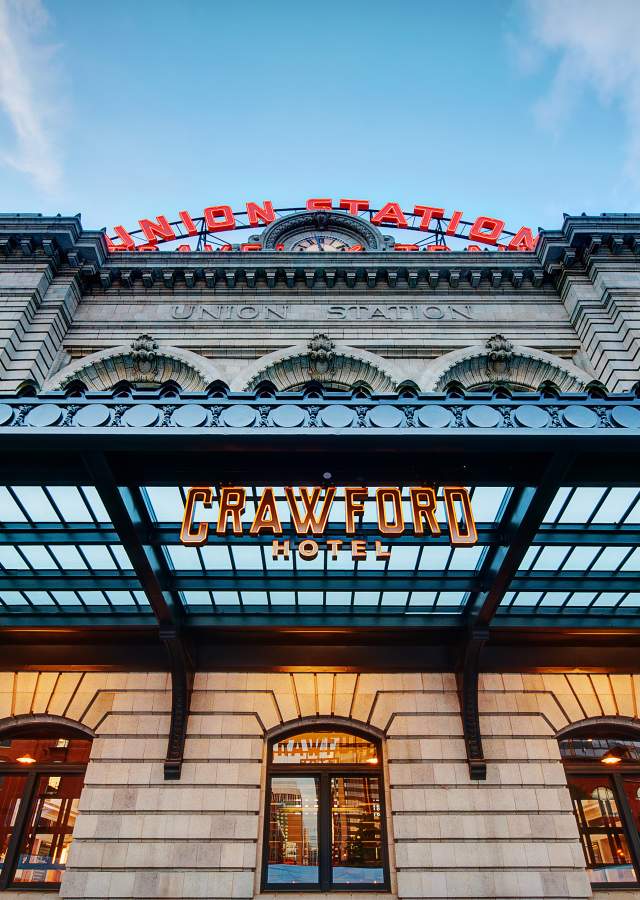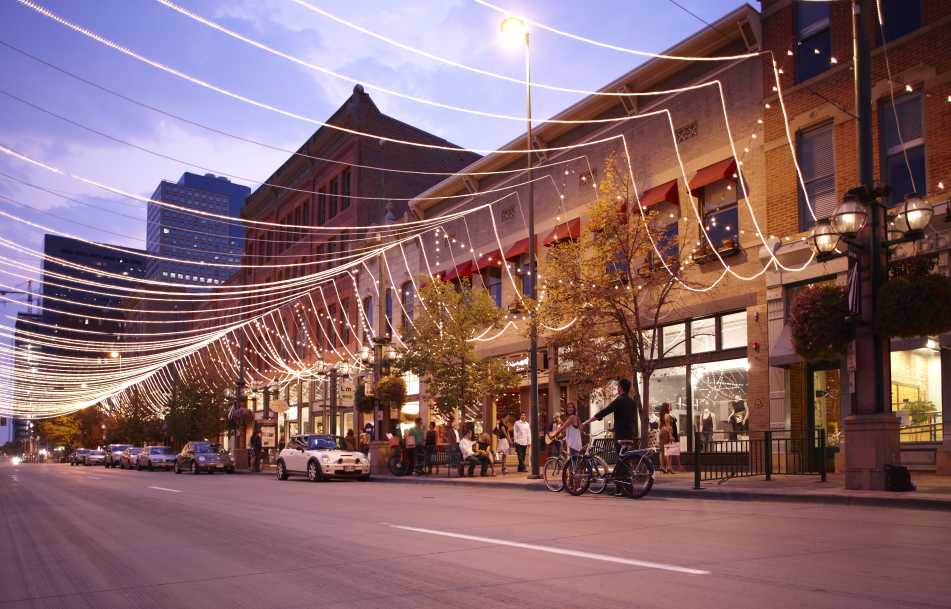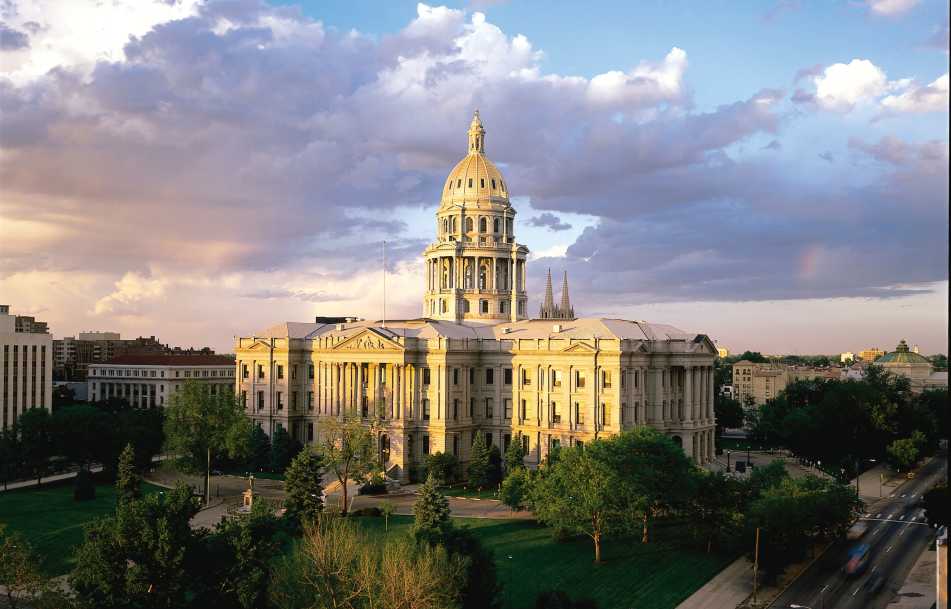
Your browser is not supported for this experience.
We recommend using Chrome, Firefox, Edge, or Safari.

This walking tour will take you to some of the best spots in downtown Denver, where the city’s past and present come together in utterly unique ways. Many of the sites and buildings are listed as official Denver Landmarks, or included in the National Register of Historic Places. Many also have historic markers and plaques noting their original intended purpose and construction dates.
Use the 16th Street Mall as your anchor. Designed in 1982 years ago by I.M. Pei, the 16th Street Mall is a mile-long pedestrian promenade lined with outdoor cafes, flower baskets and retail shops, making it the perfect starting point for an adventure-filled day. Free shuttles travel both directions the entire length of the Mall from early morning to late at night. They stop at every intersection so it’s easy to cover a lot of ground in a short period of time. Grab yourself a cup of coffee and let the day begin.
LODO (LOWER DOWNTOWN)
This area comprises a 25-block area that just a decade ago, wasn’t much more than abandoned warehouses and rail yards. Today, it has been restored and renovated to make LoDo (Lower Downtown) one of the liveliest areas in the city - not to mention one of the most historic.
UNION STATION
1701 Wynkoop St.
Start your tour of the area at Union Station. At its height, 70 trains a day at one time passed through Denver. Not quite as many trains pass through Union Station these days, but the beautiful building (originally constructed in 1881) still attracts visitors with its Breaux Arts-style design, expansive interior and stone clock tower. Cross Wynkoop Street and learn about the early history of the area from historic markers that can be found on buildings at 1801 Wynkoop St. (The Littleton Creamery - Beatrice Warehouse) and 1635 17th St. (the Denver City Railway Building). NOTE: Denver’s historic Union Station is undergoing a major restoration as it moves towards becoming the city’s main transportation hub, opening in July 2014. Access to the station may limited.
COORS FIELD
2001 Blake St.
Keep walking down Wynkoop towards Coors Field, the home of the Colorado Rockies, the Major League Baseball team established in 1993. Though it was constructed in the mid-90s, the ballpark has already earned a reputation as one of the best in the country, combining state-of-the-art technology with a nostalgic ambiance. It was modeled after the Camden Yards Ballpark in Baltimore, and its red brick construction matching the red brick architecture of much of LoDo. Don’t miss the baseball art displays as you enter from Wynkoop.
OXFORD HOTEL
1600 17th St.
Your next LoDo stop is the classic Oxford Hotel, the oldest still-standing hotel in Denver, constructed in 1891. You’ll find a historic marker on the outside that will give you the lowdown on this LoDo gem. Inside, take a look at the Cruise Room, an Art-Deco bar that was designed after a lounge on the Queen Mary cruise ship.

Coors Field

LoDo's Larimer Square
ROCKMOUNT RANCH WEAR
1626 Wazee St.
Just across the street from the Oxford on Wazee is the famed Rockmount Ranch Wear. A Denver original, fashion pioneer Papa Jack Weil invented the western snap-button shirt and opened shop back in 1946. Jack passed away at the grand old age of 107 in 2008, but not before he sold his shirts to presidents and rock stars alike including Eric Clapton and Bruce Springsteen. Stop by the flagship store, now run by Jack's grandson, to browse the incredible selection of western-style shirts, hats and accessories.
LARIMER SQUARE
Larimer St. between 14th and 15th Sts.
More Denver history can be found in Larimer Square. It was here that the city got its name, when in the 1850s, representatives from various settlements in the area got together over a barrel of whiskey and decided to consolidate their resources under the Denver name. Denver was originally named after James Denver, the Kansas Territorial Governor at the time after the merging of the settlements Denver City and Auraria. Today, Larimer Square is one of the most stylish spots in the city, with high-end fashion boutiques, chef-owned restaurants and cafes and much more. Note: If you continue walking north on 15th St., you can get to such popular attractions as the Downtown Aqaurium and the Children’s Museum of Denver and up-and-coming neighborhoods like Highlands.
TATTERED COVER BOOK STORE
1628 16th St.
On the corner of 16th and Wynkoop, you’ll encounter one of Denver’s most treasured attractions - the independently owned and operated Tattered Cover Book Store. Of course, calling Tattered Cover merely a “bookstore” is doing it some injustice. Its multileveled location is filled wall to wall with books, magazines, greeting cards, gifts and souvenirs. There’s also a great café serving coffee, pastries and sandwiches. This is a great spot to take a break in and settle in with a good book - browsing is strongly encouraged! Also enjoy the architecture. This building once housed the Morey Mercantile warehouse business which thrived in the late 19th century.
MUSEUM OF CONTEMPORARY ART DENVER
1485 Delgany St.
Much of what you’ll find in LoDo still retains its historic feel, but that doesn’t mean there isn’t room for modern architectural wonders. Case in point: the recently opened Museum of Contemporary Art Denver, at 15th and Delgany, designed by cutting edge London architect David Adjaye. Its sleek exterior houses works by some of today’s most innovative artists.
MILLENNIUM BRIDGE
16th St. and Chestnut Pl.
Connecting Riverfront Park and the 16th Street Mall is the Millennium Bridge, constructed in 2002. This unique tubular steel footbridge was designed to resemble the mast of a great ship, stretching an impressive 200 feet into the sky. Either climb the stairs or take the glass elevator to the top. From there, you’ll be treated to a great view of downtown, as well as the Platte River. On the other side of the bridge, Riverfront Park is a wonderful spot to relax and enjoy the gently rolling Platte River.
THEATRE DISTRICT/CENTER OF DOWNTOWN
OK, you’ve explored LoDo - time to head to the center of downtown. Either walk up 16th Street, or hop on the free 16th Street Mall Shuttle. The Theatre District is a few blocks west on 14th Street, highlighted by the incredible Denver Performing Arts Complex.
DANIELS & FISHER TOWER
1601 Arapahoe St.
Hear those bells tolling? That’s the D&F Tower (Daniels & Fisher), one of 16th Street’s most distinctive buildings. When it was completed in 1910, this was the highest building west of the Mississippi River. It is modeled after The Campanile (St. Mark’s Bell Tower) at the Piazza San Marco in Venice and its four clocks (one for each side) are a whopping 16 feet high. So if you’re caught without a watch, just look up. The Tower was built to house one of Denver's largest early 19th century department stores. Today, the basement of the D&F Tower has been renovated into Lannie’s Clocktower Cabaret, an entertainment venue.
DENVER PERFORMING ARTS COMPLEX / COLORADO CONVENTION CENTER
700 14th St.
Ground zero for the Denver performing arts world is, naturally, the Denver Performing Arts Complex (DPAC). Located in the heart of downtown at 14th and Curtis Streets, the DPAC houses the 2,700-seat Boettcher Concert Hall (the nation’s first in-the-round concert hall), the Helen G. Bonfils Theatre Complex (with four separate stages), the 2,830-seat Temple Hoyne Buell Theatre, the Donald R. Seawell Grand Ballroom and the Ellie Caulkins Opera House. The Denver Center Theatre Company makes its home here, and since 1979 has created an impressive body of classic and contemporary drama and world premieres. Downtown Denver is filled with fun public art - pretty much everywhere you look you’ll see something. Over at the Denver Performing Arts Complex, get an eyeful of the fifty-foot tall “Dancers.” Around the corner at the Colorado Convention Center (14th and California Sts.) is “I See What You Mean,” AKA the Blue Bear. Designed by Denver-based artist Lawrence Argent, this curious, 40-foot-tall bear has rapidly become a Denver icon, and is a great spot for a family photo. The public art in Denver isn’t all visual either - stroll down the 1500 block of Curtis Street and you’ll hear Jim Green’s “Soundwalk” - there are speakers under six ordinary-looking grates connected to a tape recorder in a nearby building, playing 40 to 100 selections per hour, including rumbling, gurgling water and other whimsical sounds.
EQUITABLE BUILDING
730 17th St.
The Equitable Building, built in 1892, is designed in the lavish Italian Renaissance Revival style and features some stunning stained glass windows inside. Look for the historic marker on the exterior to learn more about this downtown landmark.
PARAMOUNT THEATRE
1631 Glenarm Pl.
The Paramount Theatre is one of many historic theaters in Denver. Built in 1930, the Paramount was originally a classic Art Deco movie house; today, it hosts an amazing array of live music and performing arts. Look for the historic marker on the exterior to learn more.
TRINITY METHODIST CHURCH
1820 Broadway
Designed in 1887 by Robert Roeschlaub, Colorado’s first licensed architect, the Trinity Methodist Church is a splendid example of the Gothic Revival style. The church was constructed entirely out of rhyolite from Castle Rock, Colo. and features a stained glass window by the Tiffany Company. Head inside to gawk at the gargantuan Roosevelt Pipe Organ - with its network of thousands upon thousand of pipes, it can make quite a sound.
GOLDEN TRIANGLE
At the end of the 16th Street Mall you’ll come upon the Golden Triangle, one of Denver’s cultural hubs, with museums (naturally), restaurants and shopping options galore. The neighborhood is also home to several wonderful art galleries, all worth a visit.
CIVIC CENTER PARK
101 W. 14th Ave.
The splendid Civic Center Park resulted from the inspiration fostered by the "City Beautiful Movement" following the Columbian Exposition in Chicago in 1893. Elements of well-designed and beautiful parkways, fountains and tree landscaping were merged together in this space and in many other U.S. city park beautification programs. The City and County Building, completed in 1932, anchors the west end of this park. During the summer months, Civic Center Park hosts multiple fun festivals. From Civic Center Park you can look over many of downtown’s architectural gems, including the Denver Public Library designed by Michael Graves and the original 28-sided Denver Art Museum designed by Gio Ponti Nearby you’ll find the Center for Colorado Women’s History at Byers-Evans House Museum, which was built in 1883 and is now a museum, and the U.S. Mint, modeled after the Plazzo Riccardi in Florene, which was built in 1904. Civic Center Park is also full of public art, from Old West-inspired pieces to modern wonders.
COLORADO STATE CAPITOL
200 E. Colfax Ave.
Modeled after the U.S. Capitol in Washington D.C., the 272-foot-high dome of Colorado’s State Capitol is covered with 200 ounces of 24kt. gold leaf. However, the truly priceless material is inside where the entire world’s supply of Colorado rose onyx was used as wainscoting. No more of the ultra-rare, rose-colored stone has been found since. Construction on the building began in 1886 and was finally completed in 1908. Free tours of the Capitol offer this and other tidbits of information as well as visits to the Senate and House of Representatives chambers.
DENVER ART MUSEUM
100 W. 14th Ave. Parkway
One of the city’s newest architectural jewels, the Denver Art Museum's striking Hamilton Building opened to rave reviews in October 2006. Its bold, jagged look was inspired by the Rocky Mountains and geometric rock crystals found in the foothills near Denver. Of course, the original building built in 1971 and designed by Italian architect Gio Ponti remains an impressive part of the Denver landscape, and is renowned for its collection of Native American art and artifacts. The art inside DAM is impressive, but the buildings themselves are attractions all on their own.

The gold-domed Colorado State Capitol.
Denver Itinerary: 3 Days
Get ready to shop, take in the sights and see the best of Denver with our three-day itinerary.
Regional Itineraries
As home to Denver International Airport, The Mile High City is the perfect place to kick-off any Colorado and beyond trip. Get some ideas on how you…
Colorado and Utah - Denver to Denver
11 nights Denver to Denver Route: Denver, CO (2) - Glenwood Springs, CO - Gateway, CO, - Moab, UT - Mesa Verde, CO - Durango, CO - Colorado…
Colorado Circle - Denver to Denver
8 nights Denver to Denver Route: Denver, CO (2) – Grand Lake or Estes Park, CO - Grand Junction, CO (2) - Durango, CO (2) – Denver,...
Mountains to Canyons - Denver to Las Vegas
14 nights Denver to Las Vegas Route: Denver, CO (2) – Grand Lake , CO – Grand Junction, CO (2) – Moab, UT(2) – Torrey, UT…
Real American West - Denver to Denver
14 nights Denver to Denver Route (Yellowstone Park): Denver, CO (2) - Cheyenne, WY - Rapid City, SD (2) - Cody, WY - Yellowstone National Park…
Day Trips
Whether you have a few hours, a few days or a week in The Mile High City, here are some suggested itineraries and trips for visitors.
A Weekend Full of Family Fun in Denver
The Mile High City is an amazing destination for kids. In addition to the world-class Denver Zoo and Denver Museum of Nature & Science, there are…
A Weekend in Denver
There’s a lot to do in Denver, but three days gives you plenty of time to take in much of what the city has to offer without feeling like…
Beer Walking Tour: LoDo to LoHi
It is estimated that more than 200 different beers are brewed in Denver every single day, giving The Mile High City its claim as the “Napa…
Business Traveler's Itinerary
If you’re in town for a convention or business meeting, chances are good that your free time is going to extremely limited – there are…
Denver Art in One Day
Denver's art world is booming, and thanks to the city's walkability, visitors can experience some of the best artsy attractions on foot in a…
Denver LGBT: 3-Day Weekend
Denver has the most vibrant LGBTQ+ scene in the Rockies, with citywide annual events and a busy club scene. The Mile High City is also home to one of…
Denver's Beat Legacy
More than half a century after the publication of Jack Kerouac's era-defining novel, On The Road, was published, the taboo-shattering exploits of…
Denver's Best Photo Opportunities
With 300 days of sunshine and a skyline framed by the spectacular Rocky Mountains, it's no wonder that Denver has attracted a wide array of…
Dinosaurs in Denver
If you love dinosaurs, Denver is the place to be. The city lies on some of the most fossil-rich land in the world, which means finding a piece of…
Downtown Denver
Lower Downtown Denver (LoDo) is hot. The neighborhood has been completely restored and renovated over the years, making LoDo one of the liveliest…
Free Activities
You don’t have to break the bank to have a great time in Denver. Throughout the city, there are countless attractions and activities that will…
Free Denver Tours
For the budget-minded, Denver is the perfect spot for an affordable vacation getaway. These free tours take you behind the scenes at several unique…
Girlfriend's Getaway
Get away with the girls! From spas to shopping, from dining to dancing, Denver has everything you need for an unforgettable girlfriend getaway…
Golden Triangle/Colfax
Stimulating cultural attractions, appealing green space, countless restaurants and a hopping nightlife are all within walking distance when you begin…
Hidden Gems in Denver
Beyond the big-ticket attractions, Denver is home to a wide array of smaller, but no-less-fascinating attractions that make for unforgettable…
High-Altitude Experiences In Denver
Get a mile high (and much higher) in The Mile High City. From chic lounges located above downtown to the highest paved auto road in North America…
Highlands
Spend a day in the Highlands, one of Denver’s great neighborhoods, just a few minutes northwest of downtown. This community, which has…
Off-Beat Denver Tours
See Denver through a different lens! These guided tours offer VIP access to some of The Mile High City’s greatest hidden gems. Find out how…
Public Art Walking Tour
Great art isn’t just in museums in Denver. All over the city, you’ll find gorgeous murals, whimsical sculptures and other kinds of public…
Rock 'n' Roll Experiences in Denver
Looking to rock out in The Mile High City? Here's a look at some of your options. Air guitar is encouraged.
Ten Romantic Mile High City Spots
During the summer months, there's no better spot to snuggle than under the stars at Denver Botanic Gardens, a blooming botanical paradise in which…



































